Abstract
Biomechanical analysis has been one of the most used procedures when aiming to improve performance in sports and is also very relevant and decisive in the final classification of competitive events in sports such as gymnastics. Hence, this study sought to provide an overview of the number of scientific literature publications related to biomechanics research in gymnastics. The document search was completed in March 2023 and reflected a bibliometric analysis considering the published manuscripts up to 31 December 2022. Data collection was performed on the Web of Science, following the bibliometric analysis law, using Microsoft Excel and VosViewer Software (v1.6.19) for analysis and data processing. A total of 325 documents related to the topic under study were located. The results highlight that the older manuscripts date from 1980, with a growing trend of publications from that moment until now and a very visible increase in 2015, and that Sport Science is the category associated with more published manuscripts. A total of 30 manuscripts have 30 or more citations, 746 authors and co-authors are associated with the publications, and 58 co-authorships have published one or more studies. Moreover, 47 countries or regions have been associated with the topic under study, with the USA, England, and Australia being the countries with the most published articles and citations. The study also found that the highest frequency keywords are: “gymnastics” (n = 122), “biomechanics” (n = 73), “simulation” (n = 27), and “performance” (n = 25), considering the average year of publication of the documents, “balance” (n = 11), “artistic gymnastic” (n = 14) and “training” (n = 25) are the most frequently used terms. This study reveals that the topic of biomechanics in gymnastics has shown sustained growth and deserves the attention of the scientific community, but at the same time, there is still much room for research development.
1. Introduction
Biomechanical analysis has been one of the variables considered when aiming to improve performance in sports and is also very relevant and decisive in the final classification of competitive events in sports such as gymnastics. In 2015, gymnastics was indicated as a popular sport with 50 million participants worldwide [1], involving the performance of complex dynamic exercises combined with technical precision and balance [2,3]. Eight sports are governed by the Fédération Internationale de Gymnastique (FIG), including gymnastics for all, men’s and women’s artistic gymnastics, rhythmic gymnastics, trampoline gymnastics (including double mini-trampoline and tumbling), acrobatic gymnastics, aerobic gymnastics, and parkour. Although, some disciplines are not currently recognized by the Fédération Internationale de Gymnastique, namely wheel gymnastics, aesthetic group gymnastics, TeamGym, and Mallakhamba.
Skills in this sport are performed in a relatively stable and predictable environment, generally categorized as closed skills [4]. For this reason and until today, coaches follow methodologies that promote automaticity of the movement and reduce its variability [5]; nevertheless, gymnasts perform highly complex skills on diverse apparatus, each with specific characteristics and requirements [6], and international-level athletes employ complex biomechanical and neuromuscular actions during training and competitive moments [7].
These sports have been associated with an early specialization process, with, for example, rhythmic and artistic gymnastics being associated with the engagement of girls as young as 4 years old in regular training [8]. Considering the daily training routines, elite-level gymnasts are exposed to intense loading, training 21–37 h per week [9] with high-frequency landing impact loads (over 200 times a week) [10], and the peak vertical ground reaction force (vGRF) reaching 7.1–15.8 times the athlete’s body weight (BW) [1]. Those facts were previously associated with a high rate of lower extremity injuries in gymnasts [11,12], derived from the combination of technical skill, physical competency, and high training loads [13,14].
Considering some particularities, artistic gymnastics, previously indicated as the most common competitive discipline, involves gymnasts performing short routines on different apparatus, requiring flexibility and strength [15]. The highest final score (F-score) and consequent classification in men’s and women’s competitive events is related to the sum of the difficulty (D-score) and the execution score (E-score) [16].
In acrobatics, the gymnasts collaborate in pairs or groups to execute balance and dynamic elements. Motor control is extremely important in daily human tasks and a determinant of sports performance. Particularly, differences in balance ability have been observed between different types of sports [17], specifically in gymnastics; continuous postural control by the gymnasts is required to achieve success [18]. As an example, in Acrobatic Gymnastics, gymnasts perform individual static postures (held for two seconds) and compulsory static group positions (called pyramids, held for three seconds) with the top partner in different positions above the other gymnasts).
In balance elements, a considerable proportion of the final competition score is based on the correct execution of pair/group pyramids formed by at least one gymnast in the base of the formation, which supports the partner(s) on the top while maintaining static postures for at least three seconds [19]. In dynamic elements, base(s) use(s) the body to launch or impulse the top gymnast. Moreover, in disciplines such as Teamgym, the code of points [20] allows some variability of movement without deductions in the execution score, namely, for joint angle amplitude.
The biomechanical analysis is determinant in gymnastics, and some technical elements such as piked body, straight arm press to handstand with legs together, or extended at the hip from toe off in a bent body position, are required as a skill for all apparatus, except in the vault in Men’s artistic gymnastics [21]. Additionally, hip joint moment production as it shifted from extension to flexion from the leg horizontal position to the handstand position is a key performance indicator in highly skilled gymnastics [22]. Due to the previous reasons, biomechanics analysis in gymnastics is a very important factor from a training [23,24] and a research perspective [25,26]. The analysis of the movements in some exercises lets us know how the acceleration of some body segments directly influences the acceleration of other body parts [27]; that is the reason why optimization of the movements must be carried out.
Some biomechanics details were associated with injury incidence in gymnastics, with indications that the muscle activity differs depending on the landing task, whether it demands a full stop of the motion or a rebound in drop jumps [28]. Since landings in gymnastics are a crucial element that is incorporated in every routine in each artistic gymnastic event, gymnastics should be both proper in terms of judge scores and safe for the athlete [29]. Recently, Niespodziński et al. [30] evaluated neuromuscular characteristics of gymnasts’ jumps and landings at stages of sports training; the youngest participants were characterized by an elevated activation of the rectus femoris muscle, which may be considered a potential risk factor for anterior cruciate ligament injuries [31,32].
Moreover, details associated with variability in gymnastics were previously considered. Inter-variability (i.e., the variation in movement parameters between gymnasts when performing the same task [33,34]) was observed during tasks such as the handstand and handspring front somersault on vaulting [35,36]. Intra-variability (i.e., the variations in movement parameters along repetitions of the same task performed by the same subject) [33,34] was observed for step velocity [37] duration of the approach run [38], last step–springboard distance [39], body position during vaulting table take-off [40] and duration of contact to the vaulting table [37].
As it seems necessary to broaden the knowledge related to the study of the documents related to biomechanics and gymnastics, an analysis of previous literature may help to understand the evolution of research on this topic to ultimately provide an evolved vision on how to further study the sport. A bibliometric review is a reliable and valid method to identify the advances and the relationship between the authors, institutions, and countries that contribute to developing the different studies selected [41], and it allows the authors to identify future lines of investigation. Hence, the present study aimed to carry out a bibliometric analysis related to the documents that analyze the biomechanics in gymnastics, expecting to provide information about the evolution of the studies that analyze different factors that influence the physical performance of the athletes.
2. Materials and Methods
2.1. Design
Taking as a reference the classification established by Montero and León [42], the present study falls within the “Ex post facto retrospective” studies because bibliometric research related to the biomechanical study in gymnastics is the focus of this study. A bibliometric review will allow us to understand the status of a thematic line about different factors and variables [43] and to establish future lines of research.
2.2. Data Source
The document search was completed in March 2023. For this purpose, documents included in the Web of Science (WOS) database, specifically the WOS Core Collection, were selected, based in different phases (please see Supplementary Materials). Only this database was used, as it is considered to include the highest number of documents, as well as allowing the results to be classified according to the type of document, authors, affiliations, or the number of citations received. Only the WOS database was selected in order to standardize the information related to this type of study [44]. Additionally, it is estimated that between 95% and 99% of the documents indexed in the WOS database are in the Scopus database [45]. Furthermore, it is the regular database used to carry out bibliometric analyzes [46,47].
2.3. Search Strategy
For the search of the documents, the keywords “biomechanic*” and “gymnastic*” were used, using the search filter “Topic”, thus allowing a greater number of documents to be located related to the topic selected. Additionally, using the asterisk in the terms allows us to identify those key terms that have the same root in the words entered in the search. No language filter was used. Firstly, the search of the documents was carried out by two researchers (VHB and JMG) to identify the most relevant documents related to the topic, delete the duplicate documents, and reduce the bias of the results. Afterward, any disagreements in the search process and identification of the documents were resolved by two more researchers (ME and KL). Finally, a total of 175 documents, including the keywords “biomechanic*” and “gymnastic*” and derived ones used in the search, were selected. Inclusion and exclusion criteria were established at the beginning of the study to select the most relevant studies according to the topic selected. Only original and review articles were selected [48] and published up to 31 December 2022. Studies published in books, book chapters, conference abstracts, and thesis were not considered and excluded (a total of 49 documents). The articles published in 2023 were deleted due to the fact that the year is incomplete. Figure 1 shows the search strategy and the number of documents identified in each phase.
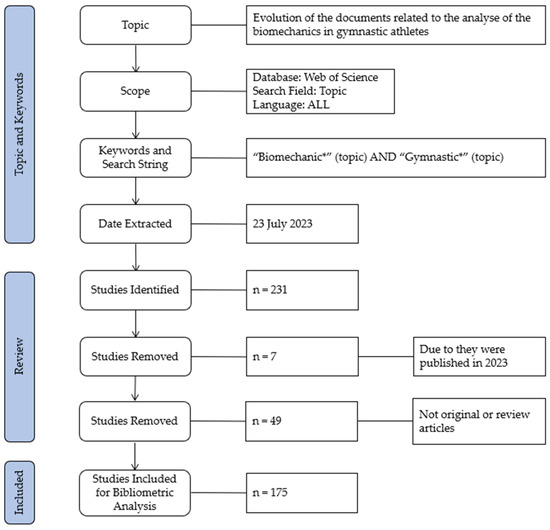
Figure 1.
Flow chart of the documents search.
2.4. Statistical Analysis
The bases for bibliometric analysis were established to carry out the statistical analysis [49,50]. The exponential growth of the documents was determined using Price’s law [50]. To identify the authors with the highest number of documents, Lotka’s analysis [51] was employed, and, using the H Index [52], the authors with the highest number of documents and citations were determined [53]. Finally, Zipf’s law was used to select the key terms most used by the authors in their studies [54].
The data was downloaded in different formats, Excel and plain text, for further analysis using Microsoft Excel (2006 version: Microsoft Corporation, Redmond, WA, USA) and VOSviewer (v1.6.19, Center for Science and Technology Studies, Leiden, The Netherlands) software for the visualization of the results.
3. Results
3.1. Anual Publication Trends
A total of 175 documents were selected. The oldest articles were: “Interpretation of Biomechanical Data to a Gymnastics Coach” [55] and “Biomechanical Model of the Press Handstand in Gymnastics” [25], published in 1981 and 1988, respectively. From 1981 to 1998, there is no continuity in the number of documents published.
On the contrary, 1998 is the year in which a minimum of 1 publication per year was identified, presenting a continuity of studies up to the present, with an exponential growth of 63.74%. The year 2021 was the year in which the greatest number of studies were conducted (n = 22) (Figure 2).
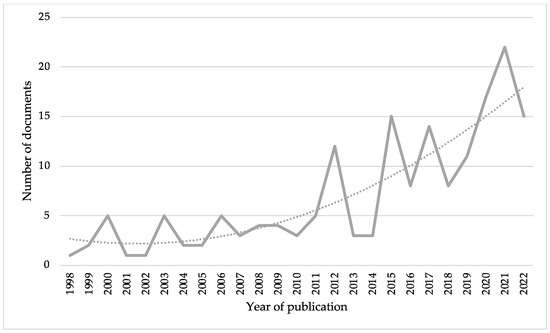
Figure 2.
The exponential growth of annual publications.
3.2. WOS Categories
Table 1 shows the results for the Top 10 WOS categories, the number of documents included in each category, as well as the corresponding percentage of the total number of documents. In the same way, it is shown the journal with the highest number of documents within each WOS category. Each journal can be included in different WOS categories due to its topic or theme.

Table 1.
Documents classified regarding the WOS categories.
The “Sport Science” category (n = 120) and the journal “Sports Biomechanics” (n = 19) include the largest number of studies. In addition, this journal is also included in the Engineering Biomedical category (n = 19). The second journal with the highest number of documents is “Human Movements Science” (n = 7), which is included in “Neuroscience”, “Psychology Experimental”, and “Psychology” WOS categories. Consequently, the number and percentage of documents per WOS category can be higher than the total of documents included in the bibliometric analysis because each document can be included in different categories regarding its topic.
3.3. H-Index
After applying the H-index to the results obtained, 41 of the selected studies presented 41 or more citations. In this way, only two of the selected documents show more than 150 quotes [56,57], with 193 and 155 citations, respectively, with an average of 64 citations per manuscript (Figure 3).
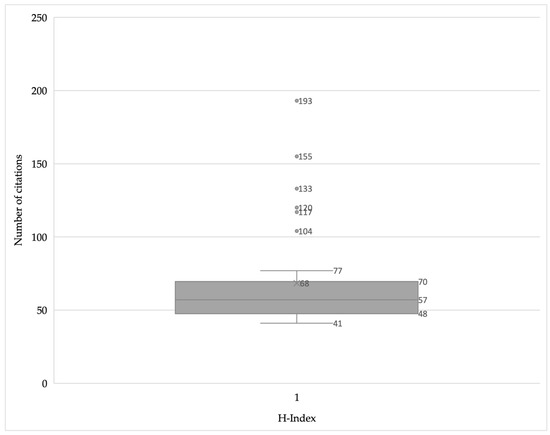
Figure 3.
Number of citations of the documents.
3.4. Most Cited Documents
Table 2 shows the top 10 documents with the highest number of citations, as well as their respective authors and the number of citations received per year since its publication. It shows that the article of Farana et al. [57] is the most cited per year (77.5) because it was published in 2022 and actually has a total of 155 citations. So, it shows that it is the most relevant article in relation to the study of biomechanics in gymnastics.

Table 2.
Articles with a higher number of citations.
3.5. Authors and Co-Authors of the Documents
Table 3 shows the 10 authors with the highest number of documents published, as well as their percentage of the total number of documents. The author Irwin, G. is the author with the higher number of documents published.

Table 3.
Number of published documents per author.
After analyzing the co-authorships found, a total of 504 authors were identified, with a distribution between 1 and 7 authors per document. Figure 3 shows the distribution and collaboration of the different authors, establishing a total of 54 co-authorships with two or more studies carried out. The most predominant network is the red one, formed by a total of eight co-authors (Figure 4). The author, Farana, R., is the most predominant author, presenting a great connection network with the other authors.
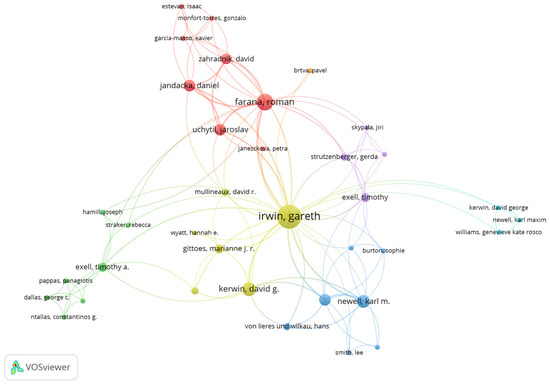
Figure 4.
Relation of co-authors.
3.6. Publications in Function of the Countries
Within the different countries that have carried out research related to the study of biomechanics in gymnastics, 40 countries or regions have been identified. There are 18 countries or regions with four or more documents and 11 with six or more. Figure 5 shows the co-authorship of the documents according to the countries or regions where they have been produced, for which a minimum of four documents per country has been established, with 17 items included in the analysis. The USA is the most productive country with a total of 46 documents (26.2%), followed by England with 25 studies, Wales (n = 23) and Australia (n = 14).
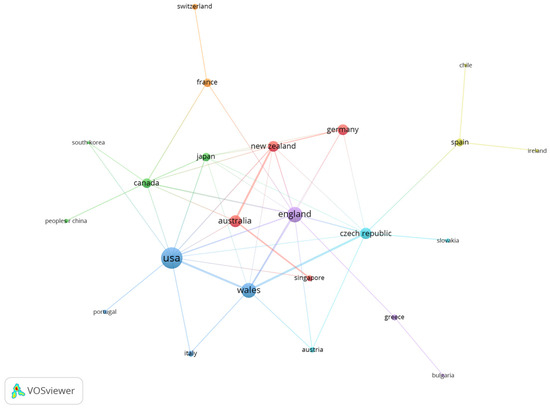
Figure 5.
Co-authorship of the countries/regions regarding the documents published.
In terms of the number of citations (Figure 6), the USA stood out from the others, with 1217 citations, followed by England (n = 294), Australia (n = 167), and Spain (n = 161).
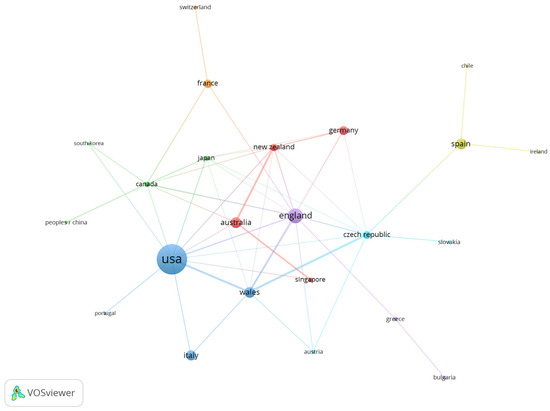
Figure 6.
Co-authorship of the countries/regions regarding the citations.
In terms of the average year of publication, Singapore and Australia are the countries or regions with a relatively old average. Portugal and Slovakia are the countries with the highest number of current publications (Figure 7).
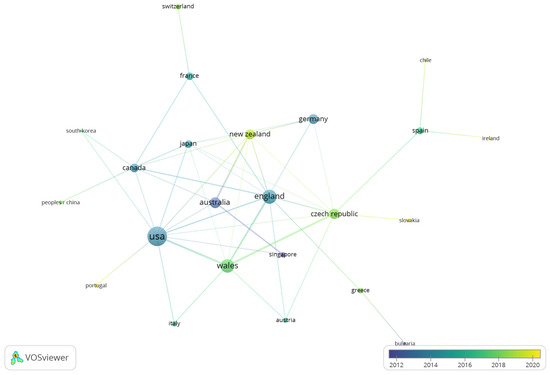
Figure 7.
Co-authorship of the countries/regions by the average year publication.
3.7. Author’s Keywords
A total of 474 keywords established by the authors were identified. After applying Zipf’s law to the frequency of keyword analysis, terms with an occurrence of six or more (the first value equal to or less than 21, as this is the square root of 474) should be selected. The terms with the highest frequency are: “gymnastics” (n = 58), “biomechanics” (n = 58), and “artistic gymnastic” (n = 10) (Figure 8).
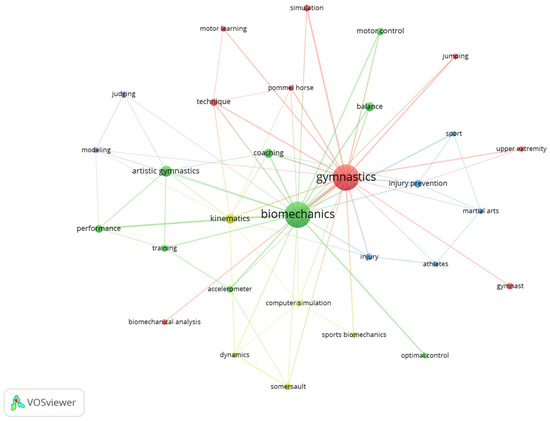
Figure 8.
Author’s keywords.
Analyzing the terms according to the average year of publication of the documents, “training”, “balance”, “motor control”, and “accelerometer” are the most frequently used terms (Figure 9).
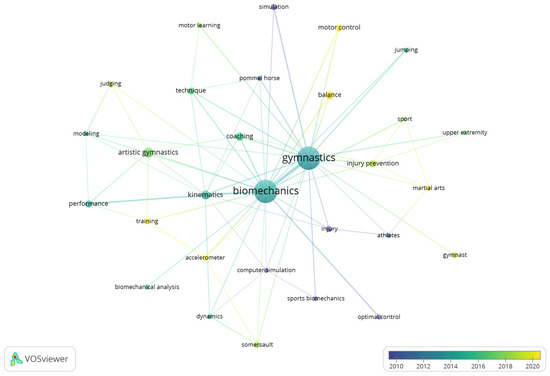
Figure 9.
Author’s keywords by average year of publication.
4. Discussion
This research aimed to perform a bibliometric review considering the biomechanics in gymnastics. The main findings were: (1) 175 documents have been published related to the study of biomechanics in gymnastics; (2) The oldest manuscript date from 1980 [23], without continuity in the publications until 1998, with an exponential growth of 63.74% until now, with 2021 being the year with the greatest number of documents published (n = 22); (3) Sport Science is the category associated with more published manuscripts (n = 120), and the journal “Sports Biomechanics” includes the largest number of studies (n = 19); (4) An H-Index of 41 was identified; (5) Irwin, G. is the author with the highest number of documents related to biomechanics in gymnastics (n = 22); (6) A total of 504 authors and co-authors are associated with the publications; (7) 40 countries have been associated with the topic under study and 18 countries have a minimum of 4 documents published; (8) USA, England and Wales are the countries with the most published articles; (9) Portugal and Slovakia are the countries with the highest number of current publications and; (10) The highest frequency keywords are: “gymnastics” (n = 58), “biomechanics” (n = 58), and “artistic gymnastic” (n = 10).
The oldest articles found were: “Interpretation of Biomechanical Data to a Gymnastics Coach” [55] and “Biomechanical Model of the Press Handstand in Gymnastics” [25], published in 1981 and 1988, respectively. From 1981 to 1998, there is no continuity in the number of documents published. Moreover, 1998 was the year in which a minimum of 2 publications per year were identified, presenting a continuity of studies up to the present, with an exponential growth of 63.74%. From 1998 to 2010 a total of 33 documents were published. On the other hand, from 2010 until now, the number of published documents increased to 133, with an average of 10 documents published per year. This evidence shows that in recent years, importance has been given to the analysis and study of biomechanics in gymnastics, which highlights the importance of this bibliometric review.
Regarding the WOS categories, this review underlines that “Sport Science” is the category with the highest number of studies (n = 120), and considering the journal, “Sports Biomechanics” is at the top with 19 studies. Likewise, this journal is included in the “Engineering Biomedical” WOS category (29 studies). As a result of the application of the H-index, we observed that 41 of the selected studies have 41 or more citations. Only two of the selected documents show more than 150 citations [56,57], with 193 and 155, respectively. It shows the interest of the scientific community in those studies because they analyze the importance of injury prevention in women’s gymnastics [56] and establish future directions in this sport discipline, considering the biomechanical, motor control and the importance of the coach interface with the athletes [57]. Identifying future lines of research will provide the scientific community, coaching staff, and athletes with important information related to the sport.
A total of 11 authors were involved in 6 or more publications related to biomechanics in gymnastics, with special emphasis on Irwin, G. and Farana, R., with 22 and 11 documents published, being 18% of the total documents identified and included in the bibliometric analyzes. Identifying the most prolific authors considering this topic is important for researchers to understand who are the authors with the highest number of studies and to identify the most relevant documents. Moreover, it presents a big picture of the literature and the existing co-authorships [58]. This information highlights that there is still plenty of room for the development of research in this area of study and that new interest groups are needed to add specific knowledge regarding biomechanics in gymnastics. It is recommended to carry out new studies that analyze the importance of different factors in the performance of gymnastics, such as motor control, balance, or accelerometry.
This study identified 40 countries where studies related to biomechanics in gymnastics have been performed, which reveals a high interest in this specific theme in gymnastics, with 18 countries with four or more documents and 11 with six or more. The USA is the most productive country, with a total of 46 documents (26.2%), followed by England with 25 studies, Wales (n = 23), and Australia (n = 14). In terms of the number of citations (Figure 5), the USA stood out from the others, with 1217 citations, followed by England (n = 294), Australia (n = 167), and Spain (n = 161). Additionally, the USA is the most prolific country in different scientific topics, such as endodontics [59], robotics [60], or physical activity and healthy habits [47]. For future scientific topics, it is recommended to carry out studies related to innovation to improve and increase the knowledge according to a topic.
Regarding the author’s keywords used, it is observed that “gymnastics” (n = 58), “biomechanics” (n = 58), and “artistic gymnastic” (n = 10) are the most used keywords. This finding is supported by the study of Bradley et al. [61], which indicated that little focus had been afforded to acrobatic gymnastics kinematics, especially in comparison to tumbling and artistic disciplines. It is important to analyze the kinematics of the movements because accelerations of corporal parts can directly influence the acceleration of other body parts [27]. For future studies, it is suggested to consider the possibility of carrying out individualized analysis of each gymnastic modality and deepen the specific knowledge of performance according to variables such as age category and gender. It is also recommended to analyze the external and internal load of the gymnastics in different disciplines, to personalize the training sessions, and to avoid injuries in the athletes.
We should indicate a limitation in this study related to the search methodology, namely choosing only two keywords, which led to the fact that some few identified studies in WOS are not specifically related to the sport gymnastics and probably some studies related to biomechanics for gymnasts may not have been selected because they do not have these two keywords. Nevertheless, this study shows the main relationships between the authors, countries, and institutions with the greatest scientific production in the topic under study, as well as journals with more published research and the most used keywords, which are important information. Future studies in this area are needed to shed more light regarding biomechanics and gymnastics. We suggest that the search methodology consider the possibility of only selecting articles specifically developed in gymnastics and exploring the prospect of deepening knowledge about specific disciplines in the sport, such as acrobatic or artistic, and potential factors influencing sports performance, such as age and gender.
5. Conclusions
This bibliometric review reveals that the topic of biomechanics in gymnastics has shown sustained growth and deserves the attention of the scientific community. Provides important information regarding the years of publication, the authors, the networks around the countries, the most used keywords, and at the same time, that there is still much room for research development. It is important to analyze which factors directly influence the athlete’s performance and how they can be improved.
Factors such as balance, motor control, accelerometry, and control of body parts in movements are variables that should be developed in training sessions to improve performance in competitions. The coaches must pay attention to some factors related to the variability to improve the development of the different tasks.
Supplementary Materials
The checklist regarding the bibliographic review guidelines can be downloaded at: https://www.mdpi.com/article/10.3390/biomechanics3040039/s1.
Author Contributions
Conceptualization: V.H.-B., M.C.E. and J.M.G.; methodology: V.H.-B., J.M.-J., K.L. and J.M.G.; formal analysis, V.H.-B., M.C.E., J.M.-J., K.L. and J.M.G.; investigation: V.H.-B., J.M.-J., K.L. and J.M.G.; supervision: V.H.-B., J.M.-J., K.L. and J.M.G.; data curation: V.H.-B., J.M.-J., K.L. and J.M.G.; writing—original draft preparation: V.H.-B., M.C.E., C.C.F., J.A.P. and J.M.G.; writing—review and editing: V.H.-B., M.C.E., J.M.-J., K.L., C.C.F., J.A.P. and J.M.G.; Visualization: V.H.-B., M.C.E., J.M.-J., K.L., C.C.F., J.A.P. and J.M.G.; funding acquisition: M.C.E., C.C.F. and J.M.G. All authors have read and agreed to the published version of the manuscript.
Funding
This study was supported by the Portuguese Foundation for Science and Technology, I.P. under Grant UID04045/2020 and Instituto Politécnico de Setúbal. Additionally, the research was partially funded by the GOERD of the University of Extremadura and the Research Vice-rectory of Universidad Nacional. This study has been partially supported by the funding for research groups (GR21149) granted by the Government of Extremadura (Employment and Infrastructure Office—Consejería de Empleo e Infraestructuras), with the contribution of the European Union via the European Regional Development Fund (ERDF) by the Optimisation of Training and Sports Performance Research Group (GOERD) of the Faculty of Sports Sciences of the University of Extremadura. Additionally, the author José M. Gamonales was supported by a grant from the Requalification Program of the Spanish University System, Field of Knowledge: Biomedical (MS-18).
Institutional Review Board Statement
Not applicable.
Informed Consent Statement
Not applicable.
Data Availability Statement
The data that support the findings of this study are available from the corresponding author upon reasonable request.
Acknowledgments
The authors would like to acknowledge the participants who allowed us to conduct this study.
Conflicts of Interest
The authors declare no conflict of interest.
References
- Slater, A.; Campbell, A.; Smith, A.; Straker, L. Greater Lower Limb Flexion in Gymnastic Landings Is Associated with Reduced Landing Force: A Repeated Measures Study. Sports Biomech. 2015, 14, 45–56. [Google Scholar] [CrossRef]
- Desai, N.; Vance, D.D.; Rosenwasser, M.P.; Ahmad, C.S. Artistic Gymnastics Injuries; Epidemiology, Evaluation, and Treatment. J. Am. Acad. Orthop. Surg. 2019, 27, 459–467. [Google Scholar] [CrossRef]
- Muehlbauer, T.; Heise, J.; Hill, M.W. Effect of Arm Movement on Balance Performance in Children: Role of Expertise in Gymnastics. BMC Res. Notes 2022, 15, 363. [Google Scholar] [CrossRef] [PubMed]
- Schmidt, R.; Lee, T. Motor Learning and Performance, 6th ed.; Human Kinetics Publishers: Champaign, IL, USA, 2020. [Google Scholar]
- Araújo, D.; Woods, C.; McCosker, C.; Carvalho, J.; Renshaw, I.; Davids, K. Functional Variability Enhances Performance in Self-Paced Tasks: An Ecological Dynamics Approach. In The Psychology of Closed Self-Paced Motor Tasks in Sports; Routledge: New York, NY, USA, 2022. [Google Scholar]
- Jemni, M.; Sands, W.A.; Salmela, J.H.; Holvoet, P.; Gateva, M. The Science of Gymnastics, 1st ed.; Routledge: Oxon, UK, 2022. [Google Scholar]
- Wu, C.; Hao, W.; He, W.; Xiao, X.; Li, X.; Sun, W. Biomechanical and Neuromuscular Strategies on Backward Somersault Landing in Artistic Gymnastics: A Case Study. Math. Biosci. Eng. 2019, 16, 5862–5876. [Google Scholar] [CrossRef]
- Rutkowska-Kucharska, A.; Szpala, A.; Jaroszczuk, S.; Sobera, M. Muscle Coactivation during Stability Exercises in Rhythmic Gymnastics: A Two-Case Study. Appl. Bionics Biomech. 2018, 2018, 8260402. [Google Scholar] [CrossRef]
- Edouard, P.; Steffen, K.; Junge, A.; Leglise, M.; Soligard, T.; Engebretsen, L. Gymnastics Injury Incidence during the 2008, 2012 and 2016 Olympic Games: Analysis of Prospectively Collected Surveillance Data from 963 Registered Gymnasts during Olympic Games. Br. J. Sports Med. 2018, 52, 475–481. [Google Scholar] [CrossRef] [PubMed]
- Gittoes, M.J.; Irwin, G. Biomechanical Approaches to Understanding the Potentially Injurious Demands of Gymnastic-Style Impact Landings. Sports Med. Arthrosc. Rehabil. Ther. Technol. 2012, 4, 4. [Google Scholar] [CrossRef] [PubMed]
- Mills, C.; Pain, M.T.G.; Yeadon, M.R. Reducing Ground Reaction Forces in Gymnastics’ Landings May Increase Internal Loading. J. Biomech. 2009, 42, 671–678. [Google Scholar] [CrossRef] [PubMed]
- Pasulka, J.; Jayanthi, N.; McCann, A.; Dugas, L.R.; LaBella, C. Specialization Patterns across Various Youth Sports and Relationship to Injury Risk. Phys. Sportsmed. 2017, 45, 344–352. [Google Scholar] [CrossRef]
- Daly, R.M. Balancing the Risk of Injury to Gymnasts: How Effective Are the Counter Measures? Br. J. Sports Med. 2001, 35, 8–19. [Google Scholar] [CrossRef]
- Caine, D.; Russell, K.; Liesbeth, L. Handbook of Sports Medicine and Science e Gymnastics; John Wiley and Sons: New York, NT, USA, 2013. [Google Scholar]
- Mkaouer, B.; Hammoudi-Nassib, S.; Amara, S.; Chaabène, H. Evaluating the Physical and Basic Gymnastics Skills Assessment for Talent Identification in Men’s Artistic Gymnastics Proposed by the International Gymnastics. Biol. Sport 2018, 35, 383–392. [Google Scholar] [CrossRef]
- Schärer, C.; Lehmann, T.; Naundorf, F.; Taube, W.; Hübner, K. The Faster, the Better? Relationships between Run-up Speed, the Degree of Difficulty (D-Score), Height and Length of Flight on Vault in Artistic Gymnastics. PLoS ONE 2019, 14, e0213310. [Google Scholar] [CrossRef]
- Gómez-Landero, L.A.; Leal Del Ojo, P.; Walker, C.; Floría, P. Static Balance Performance Differs Depending on the Test, Age and Specific Role Played in Acrobatic Gymnastics. Gait Posture 2021, 90, 48–54. [Google Scholar] [CrossRef]
- Floría, P.; Gómez-Landero, L.A.; Harrison, A.J. Centre of Pressure Correlates with Pyramid Performance in Acrobatic Gymnastics. Sports Biomech. 2015, 14, 424–434. [Google Scholar] [CrossRef] [PubMed]
- Fédération Internationale de Gymnastique. Acrobatic Gymnastics Code of Points 2020–2024. Available online: https://www.gymnastics.sport (accessed on 10 March 2023).
- Sjöstrand, P. 2022–2024 Teamgym Code of Points Seniors and Juniors; European Gymnastics: Lausanne, Switzerland, 2022; Available online: https://backend.europeangymnastics.com (accessed on 10 April 2023).
- Joshi, H.C.; Ghai, G.D.; Rajpoot, Y.S. Kinematic Analysis of Close Leg Press Handstand Performing on Different Apparatuses in Artistic Gymnastics. Int. J. Yoga Physiother. Phys. Educ. 2017, 2, 7–10. [Google Scholar]
- Mizutori, H.; Kashiwagi, Y.; Hakamada, N.; Tachibana, Y.; Funato, K. Kinematics and Joints Moments Profile during Straight Arm Press to Handstand in Male Gymnasts. PLoS ONE 2021, 16, e0253951. [Google Scholar] [CrossRef] [PubMed]
- Fukushima, S.; Russell, W. Men’s Gymnastics; Faber & Faber: London, UK, 1980. [Google Scholar]
- Bawa, G. Fundamentals of Men’s Gymnastics; Friends Publications: New Dehli, India, 1994. [Google Scholar]
- Prassas, S.G. Biomechanical Model of the Press Handstand in Gymnastics. Int. J. Sport Biomech. 1988, 4, 326–341. [Google Scholar] [CrossRef]
- Kochanowicz, A.; Niespodziński, B.; Mieszkowski, J.; Marina, M.; Kochanowicz, K.; Zasada, M. Changes in the Muscle Activity of Gymnasts During a Handstand on Various Apparatus. J. Strength Cond. Res. 2019, 33, 1609–1618. [Google Scholar] [CrossRef]
- von Laßberg, C.; Rapp, W.; Mohler, B.; Krug, J. Neuromuscular Onset Succession of High Level Gymnasts during Dynamic Leg Acceleration Phases on High Bar. J. Electromyogr. Kinesiol. 2013, 23, 1124–1130. [Google Scholar] [CrossRef] [PubMed]
- Wang, X.; Zhang, S.; Fu, W. Changes in Impact Signals and Muscle Activity in Response to Different Shoe and Landing Conditions. J. Hum. Kinet. 2017, 56, 5–18. [Google Scholar] [CrossRef]
- Kochanowicz, A.; Kochanowicz, K.; Niespodziúski, B.; Mieszkowski, J.; Aschenbrenner, P.; Bielec, G.; Szark-Eckardt, M. Maximal Power of the Lower Limbs of Youth Gymnasts and Biomechanical Indicators of the Forward Handspring Vault Versus the Sports Result. J. Hum. Kinet. 2016, 53, 33–40. [Google Scholar] [CrossRef] [PubMed]
- Niespodziński, B.; Grad, R.; Kochanowicz, A.; Mieszkowski, J.; Marina, M.; Zasada, M.; Kochanowicz, K. The Neuromuscular Characteristics of Gymnasts’ Jumps and Landings at Particular Stages of Sports Training. J. Hum. Kinet. 2021, 78, 15–28. [Google Scholar] [CrossRef] [PubMed]
- Demorat, G.; Weinhold, P.; Blackburn, T.; Chudik, S.; Garrett, W. Aggressive Quadriceps Loading Can Induce Noncontact Anterior Cruciate Ligament Injury. Am. J. Sports Med. 2004, 32, 477–483. [Google Scholar] [CrossRef] [PubMed]
- Navacchia, A.; Ueno, R.; Ford, K.R.; DiCesare, C.A.; Myer, G.D.; Hewett, T.E. EMG-Informed Musculoskeletal Modeling to Estimate Realistic Knee Anterior Shear Force during Drop Vertical Jump in Female Athletes. Ann. Biomed. Eng. 2019, 47, 2416–2430. [Google Scholar] [CrossRef] [PubMed]
- Harbourne, R.T.; Stergiou, N. Movement Variability and the Use of Nonlinear Tools: Principles to Guide Physical Therapist Practice. Phys. Ther. 2009, 89, 267–282. [Google Scholar] [CrossRef] [PubMed]
- Zhao, K.; Zhang, Z.; Wen, H.; Scano, A. Intra-Subject and Inter-Subject Movement Variability Quantified with Muscle Synergies in Upper-Limb Reaching Movements. Biomimetics 2021, 6, 63. [Google Scholar] [CrossRef]
- Kochanowicz, A.; Niespodziński, B.; Marina, M.; Mieszkowski, J.; Biskup, L.; Kochanowicz, K. Relationship between Postural Control and Muscle Activity during a Handstand in Young and Adult Gymnasts. Hum. Mov. Sci. 2018, 58, 195–204. [Google Scholar] [CrossRef]
- Irwin, G.; Kerwin, D.G. The Influence of the Vaulting Table on the Handspring Front Somersault. Sports Biomech. 2009, 8, 114–128. [Google Scholar] [CrossRef]
- Bradshaw, E.; Hume, P.; Calton, M.; Aisbett, B. Reliability and Variability of Day-to-Day Vault Training Measures in Artistic Gymnastics. Sports Biomech. 2010, 9, 79–97. [Google Scholar] [CrossRef]
- Haigis, T.; Schlegel, K. The Regulatory Influence of the Visual System: An Exploratory Study in Gymnastics Vaulting. Sci. Gymnast. J. 2020, 12, 61–73. [Google Scholar] [CrossRef]
- Heinen, T.; Vinken, P.M.; Jeraj, D.; Velentzas, K. Movement Regulation of Handsprings on Vault. Res. Q. Exerc. Sport 2013, 84, 68–78. [Google Scholar] [CrossRef] [PubMed]
- Heinen, T.; Jeraj, D.; Thoeren, M.; Vinken, P. Target-Directed Running in Gymnastics: The Role of the Springboard Position as an Informational Source to Regulate Handsprings on Vault. Biol. Sport 2011, 28, 215–221. [Google Scholar] [CrossRef]
- Gamonales, J.M.; Hernández-Beltrán, V.; Ocete, C.; Franco, E.; Mendoza, N. Evolution of Sports-Related Manuscripts for People with Intellectual Disability. Bibliometric Review. Rev. Educ. Inclusiva 2023, 16, 104–118. [Google Scholar]
- Montero, I.; León, O.G. A Guide for Naming Research Studies in Psychology. Int. J. Clin. Health Psychol. 2007, 7, 847–862. [Google Scholar]
- Arango, E.; Ceballos, R.; Osorio, C. Investigación En Publicidad Política: Un Análisis Bibliométrico. Rev. Guillermo Ockham 2020, 18, 181–189. [Google Scholar] [CrossRef]
- Herrera, J.; de las Heras-Rosas, C. Corporate Social Responsibility and Human Resource Management: Towards Sustainable Business Organizations. Sustainability 2020, 12, 841. [Google Scholar] [CrossRef]
- Singh, V.K.; Singh, P.; Karmakar, M.; Leta, J.; Mayr, P. The Journal Coverage of Web of Science, Scopus and Dimensions: A Comparative Analysis. Scientometrics 2021, 126, 5113–5142. [Google Scholar] [CrossRef]
- Denche-Zamorano, A.; Rodriguez-Redondo, Y.; Barrios-Fernandez, S.; Mendoza-Muñoz, M.; Castillo-Paredes, A.; Rojo-Ramos, J.; Garcia-Gordillo, M.A.; Adsuar, J.C. Rehabilitation Is the Main Topic in Virtual and Augmented Reality and Physical Activity Research: A Bibliometric Analysis. Sensors 2023, 23, 2987. [Google Scholar] [CrossRef]
- Hernández-Beltrán, V.; Espada, M.C.; Santos, F.J.; Ferreira, C.C.; Gamonales, J.M. Documents Publication Evolution (1990–2022) Related to Physical Activity and Healthy Habits, a Bibliometric Review. Healthcare 2023, 11, 1669. [Google Scholar] [CrossRef]
- Gamonales, J.M.; Muñoz-Jiménez, J.; León, K.; Ibáñez, S.J. 5-a-Side Football for Individuals with Visual Impairments: A Review of the Literature. Eur. J. Adapt. Phys. Act. 2018, 11, 4. [Google Scholar] [CrossRef]
- Contreras-Barraza, N.; Madrid-Casaca, H.; Salazar-Sepúlveda, G.; Garcia-Gordillo, M.Á.; Adsuar, J.C.; Vega-Muñoz, A. Bibliometric Analysis of Studies on Coffee/Caffeine and Sport. Nutrients 2021, 13, 3234. [Google Scholar] [CrossRef] [PubMed]
- Price, D.D.S. A General Theory of Bibliometric and Other Cumulative Advantage Processes. J. Am. Soc. Inf. Sci. 1976, 27, 292–306. [Google Scholar] [CrossRef]
- Coile, R.C. Lotka’s Frequency Distribution of Scientific Productivity. J. Am. Soc. Inf. Sci. 1977, 28, 366–370. [Google Scholar] [CrossRef]
- Hirsch, J.E. An Index to Quantify an Individual’s Scientific Research Output. Proc. Natl. Acad. Sci. USA 2005, 102, 16569–16572. [Google Scholar] [CrossRef]
- Crespo, N.; Simoes, N. Publication Performance through the Lens of the H-index: How Can We Solve the Problem of the Ties? Soc. Sci. Q. 2019, 100, 2495–2506. [Google Scholar] [CrossRef]
- Valderrama-Zurián, J.C.; García-Zorita, C.; Marugán-Lázaro, S.; Sanz-Casado, E. Comparison of MeSH Terms and KeyWords Plus Terms for More Accurate Classification in Medical Research Fields. A Case Study in Cannabis Research. Inf. Process. Manag. 2021, 58, 102658. [Google Scholar] [CrossRef]
- Shierman, G. Interpretation of Biomechanical Data to a Gymnastics Coach. Proc. Soc. Photo-Opt. Instrum. Eng. 1981, 291, 6–8. [Google Scholar]
- Sands, W.A. Injury Prevention in Women’s Gymnastics. Sports Med. 2000, 30, 359–373. [Google Scholar] [CrossRef]
- Farana, R.; Williams, G.; Fujihara, T.; Wyatt, H.E.; Naundorf, F.; Irwin, G. Current Issues and Future Directions in Gymnastics Research: Biomechanics, Motor Control and Coaching Interface. Sports Biomech. 2022, 22, 161–185. [Google Scholar] [CrossRef]
- Ahmad, N.; Menegaki, A.N.; Al-Muharrami, S. Systematic Literature Review Of Tourism Growth Nexus: An Overview Of The Literature And A Content Analysis Of 100 Most Influential Papers. J. Econ. Surv. 2020, 34, 1068–1110. [Google Scholar] [CrossRef]
- Yılmaz, B.; Dinçol, M.E.; Yalçın, T.Y. A Bibliometric Analysis of the 103 Top-Cited Articles in Endodontics. Acta Odontol. Scand. 2019, 77, 574–583. [Google Scholar] [CrossRef] [PubMed]
- Uivarosan, D.; Bungau, S.G.; Nistor-Cseppento, C.D.; Negru, P.A.; Bungau, A.F.; Sabau, A.M.; Tit, D.M.; Uivaraseanu, B.; Radu, A.-F. Application of Robotic Recovery Techniques to Stroke Survivors—Bibliometric Analysis. J. Pers. Med. 2022, 12, 2066. [Google Scholar] [CrossRef] [PubMed]
- Bradley, E.; Harrington, K.; Tiffin, C.A. Comparison of a Tucked Back Somersault between Novice and Experienced Acrobatic Gymnasts: An Inertial Measurement Approach. In Proceedings of the ISBS Proceedings Archive: ISBS Conference 2020, Liverpool, UK, 20–24 July 2020. [Google Scholar]
Disclaimer/Publisher’s Note: The statements, opinions and data contained in all publications are solely those of the individual author(s) and contributor(s) and not of MDPI and/or the editor(s). MDPI and/or the editor(s) disclaim responsibility for any injury to people or property resulting from any ideas, methods, instructions or products referred to in the content. |
© 2023 by the authors. Licensee MDPI, Basel, Switzerland. This article is an open access article distributed under the terms and conditions of the Creative Commons Attribution (CC BY) license (https://creativecommons.org/licenses/by/4.0/).